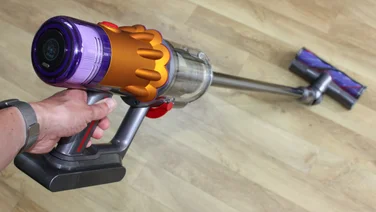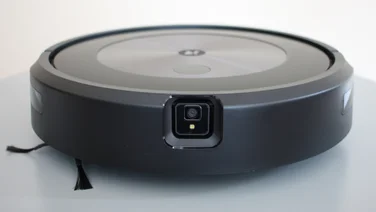To help us provide you with free impartial advice, we may earn a commission if you buy through links on our site. Learn more



























- Well-balanced and lightweight
- Uses Ryobi’s ONE+ battery system
- Impressive battery life for the price
- Struggles with large debris
- On the short side
You probably know Ryobi primarily for its range of day-glo green power tools, but DIY is not the only space the company plays in. It also has a huge range of garden tools and accessories, and has more recently branched out into domestic appliances. The Ryobi 18V ONE+ Cordless Stick Vacuum Cleaner (RSVS18BL), on review here, is one such product.
It’s reasonably priced at £200, and there’s certainly a lot to praise about this little vacuum, but can it compete with the best vacuum cleaners on the market? Read on to find out.
What do you get for the money?
Ryobi’s main selling point is the brand’s ONE+ battery system, which allows you to use one lithium rechargeable battery to run multiple different tools. In fact, the company has more than 200 different products in its cordless range, including models up to 25 years old. It’s a great idea as it can free up space in your home and garden shed and save you money, as many of Ryobi’s cordless products are available to buy for less without the battery.
For this vacuum, I was supplied with the kit version, which comes with a single 18v 4Ah battery and charger, but you can also purchase the unit as a “bare tool” without the battery for £25 cheaper if you already have a suitable battery.



























In addition to the main vacuum, wand and motorised cleaning head, there’s a healthy selection of accessories in the box, including a powered mini brush head, a crevice tool and a round brush, plus an accessory holder and a “micro crevice” attachment, which has 16 flexible straws designed to fit into tight spaces. Various configurations mean that you can use the Ryobi as a handheld unit, normal vacuum or a long reach vacuum for ceilings and the tops of cabinets and shelf units.
Price-wise, the Ryobi is considerably cheaper than many cordless vacuums with the same kind of capabilities. It’s more expensive than the older VAX Blade 4 at £124 but considerably cheaper than VAX’s newer HomePro Detect Pet-Design(£370), and the Henry Quick cordless at £330, to give a couple of examples. I’ll go into its performance more as we go along but, suffice to say, I think the Ryobi packs an impressive punch for the money.



























What is it like to use?
The battery unit and main body of the Ryobi vacuum weigh 2.3kg, with this weight increasing to 3.8kg with the extension wand and motorised head attached. This is actually heavier than the Dyson V16 I tested recently, which I found quite unwieldy in use.
Despite this, the Ryobi actually feels much lighter to clean with than the Dyson, which I think is mainly down to better weight distribution between the motorised head and battery unit. Like every cordless vacuum cleaner I’ve ever used or tested, the Ryobi is awkward to use in handheld mode but, as a standard vacuum, it whizzes over floors and carpets with a nicely balanced feel. It’s also self-standing, unlike the aforementioned Dyson, meaning you don’t have to find something to lean it against when you take a break from vacuuming.



























I was also impressed by how solid the Ryobi felt; it’s well-made and the components fit together securely. It’s easy to take apart and put back together and, as previously mentioned, having one battery and charger that can power multiple tools can help cut storage space and cost. For example, you can get hold of the Ryobi ONE+ 33cm Lawn Mower for £160 without the battery – the full kit costs £260.
The controls are on the top of the main unit and are pretty simple. There’s one button to turn the vacuum on and off, one to activate the boost feature and another to move the bristles up and down in the motorised head to protect delicate surfaces. There’s also an LED light to help out when cleaning the darker corners of your home, and the battery has three LEDs that show you how much charge you have left.



























Ryobi says the dual-cyclonic filtration of the vacuum captures up to 99.5% of particles such as pollen, fungal spores and bacteria, so this could be a good pick for allergy sufferers. The filter is easy to remove and replace thanks to a simple clip mechanism and you can buy replacements on the Ryobi website for £9.99.
As far as accessories are concerned, the smaller powered brush head works well on stairs, with the crevice tool and round brush being ideal for tighter spaces or ceilings and the tops of bookcases. I was intrigued by the micro crevice tool and found this worked very well for blinds, along with really tight spaces I couldn’t fit the crevice tool into. However, user reviews do suggest that some found it a little flimsy – I didn’t run across any such problems, but I would recommend using it delicately.
The one other thing to note is that the extension wand is a little shorter than on other vacuums. I am 5ft 9in tall and my husband is just under 6ft, and we both noticed we had to bend over a little more than usual with the Ryobi, certainly more than with the Dyson V16 Piston Animal we’ve been using of late. It’s not a deal breaker but, if you’re over 6ft, you might find it a little more awkward to use over a longer period of time.
How well does it clean?
All our vacuum cleaners are all tested in the same way. We take Cheerios, flour and pet hair and spill measured amounts of each onto short-pile carpet and hard floor. We then run over each spill in a single pass with the vacuum set to maximum power so gauge how much it collects. We measure the vacuum’s suction power with a vacuum gauge as well.
I was impressed by the suction power of the Ryobi in Eco mode, with a reading of 13kPa. This was the highest reading of any vacuum we’ve tested to date, beating even the Dyson V15.
With Boost mode enabled, the Ryobi performed more in line with its price tag, with a still acceptable reading of 20kPa. Battery life was also impressive for the cost of the Ryobi: it lasted 45mins 24 seconds in Eco mode and 17mins 45secs in Boost mode.






















































It was more of a mixed bag when it came to cleaning efficiency. Despite the lack of an anti-hair wrap head, the Ryobi did a good job with pet hair, picking up 100% of our sample on carpet. In real-world testing, I noticed that a few of my own long hairs became wrapped around the brush bar, so you’ll need to remove the bar to snip them off from time to time. On hard flooring, the Ryobi picked up 3g out of the 5g of pet hair with its standard motorised head.

















































































The Ryobi also dealt with our plain flour test pretty well, picking up 45g out of 50g on carpet and 48g on hard flooring. The Cheerio test, as with so many vacuums, presented the biggest challenge. Much like the Henry Quick Corded that I tested at the same time, the Ryobi’s motorised head simply doesn’t have a big enough inlet at the front to pick up these big particles efficiently – you’ll need to swap to the crevice tool to clean up a spill of this type. On hard flooring, it pushed the Cheerios in front of it, only picking up 1g.
Another issue here was that some of the Cheerios got stuck at the top of the extension wand and didn’t make it into the collection bin, due to a rather narrow bin inlet and the rubber flap covering it getting a bit stuck. This also meant some Cheerios ended up on the floor when I emptied the collection bin.
Should you buy the Ryobi 18V ONE+ Cordless Stick vacuum cleaner?
The Ryobi 18V One+ is not without its negative points, then. There’s no anti-hair wrap head, which isn’t ideal if you have people with long hair in the house, and larger particles can cause blockages. It’s also worth thinking about how tall you are, as I do think those over 6ft might get a little irritated with the slightly shorter extension wand.
But apart from these niggles, this is a solid little machine that’s really well priced for its performance levels. It glides around the house with ease. It has an impressive battery life and decent levels of suction, it’s easy to use and is well-built to boot.






